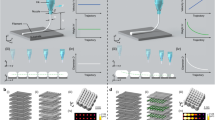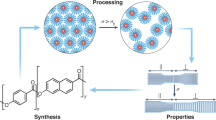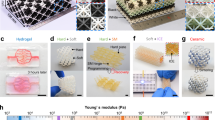Abstract
There is growing interest in voxelated matter that is designed and fabricated voxel by voxel1,2,3,4. Currently, inkjet-based three-dimensional (3D) printing is the only widely adopted method that is capable of creating 3D voxelated materials with high precision1,2,3,4, but the physics of droplet formation requires the use of low-viscosity inks to ensure successful printing5. By contrast, direct ink writing, an extrusion-based 3D printing method, is capable of patterning a much broader range of materials6,7,8,9,10,11,12,13. However, it is difficult to generate multimaterial voxelated matter by extruding monolithic cylindrical filaments in a layer-by-layer manner. Here we report the design and fabrication of voxelated soft matter using multimaterial multinozzle 3D (MM3D) printing, in which the composition, function and structure of the materials are programmed at the voxel scale. Our MM3D printheads exploit the diode-like behaviour that arises when multiple viscoelastic materials converge at a junction to enable seamless, high-frequency switching between up to eight different materials to create voxels with a volume approaching that of the nozzle diameter cubed. As exemplars, we fabricate a Miura origami pattern14 and a millipede-like soft robot that locomotes by co-printing multiple epoxy and silicone elastomer inks of stiffness varying by several orders of magnitude. Our method substantially broadens the palette of voxelated materials that can be designed and manufactured in complex motifs.
This is a preview of subscription content, access via your institution
Access options
Access Nature and 54 other Nature Portfolio journals
Get Nature+, our best-value online-access subscription
$29.99 / 30 days
cancel any time
Subscribe to this journal
Receive 51 print issues and online access
$199.00 per year
only $3.90 per issue
Buy this article
- Purchase on Springer Link
- Instant access to full article PDF
Prices may be subject to local taxes which are calculated during checkout





Similar content being viewed by others
Data availability
The datasets generated or analysed during the current study are available from the corresponding author on reasonable request.
Code availability
The code generated during the current study is available from the corresponding author on reasonable request.
References
Hosny, A. et al. From improved diagnostics to presurgical planning: high-resolution functionally graded multimaterial 3D printing of biomedical tomographic data sets. 3D Print. Addit. Manuf. 5, 103–113 (2018).
Bader, C. et al. Making data matter: voxel printing for the digital fabrication of data across scales and domains. Sci. Adv. 4, eaas8652 (2018).
Gu, G. X., Chen, C. T., Richmond, D. J. & Buehler, M. J. Bioinspired hierarchical composite design using machine learning: simulation, additive manufacturing, and experiment. Mater. Horiz. 5, 939–945 (2018).
Gu, G. X., Chen, C. T. & Buehler, M. J. De novo composite design based on machine learning algorithm. Extreme Mech. Lett. 18, 19–28 (2018).
Jang, D., Kim, D. & Moon, J. Influence of fluid physical properties on ink-jet printability. Langmuir 25, 2629–2635 (2009).
Truby, R. L. & Lewis, J. A. Printing soft matter in three dimensions. Nature 540, 371–378 (2016).
Raney, J. R. et al. Rotational 3D printing of damage-tolerant composites with programmable mechanics. Proc. Natl Acad. Sci. USA 115, 1198–1203 (2018).
Wehner, M. et al. An integrated design and fabrication strategy for entirely soft, autonomous robots. Nature 536, 451–455 (2016).
Valentine, A. D. et al. Hybrid 3D printing of soft electronics. Adv. Mater. 29, 1703817 (2017).
Kotikian, A., Truby, R. L., Boley, J. W., White, T. J. & Lewis, J. A. 3D printing of liquid crystal elastomeric actuators with spatially programed nematic order. Adv. Mater. 30, 1706164 (2018).
Kong, Y. L. et al. 3D printed quantum dot light-emitting diodes. Nano Lett. 14, 7017–7023 (2014).
Kolesky, D. B., Homan, K. A., Skylar-Scott, M. A. & Lewis, J. A. Three-dimensional bioprinting of thick vascularized tissues. Proc. Natl Acad. Sci. USA 113, 3179–3184 (2016).
Compton, B. G. & Lewis, J. A. 3D-printing of lightweight cellular composites. Adv. Mater. 26, 5930–5935 (2014).
Schenk, M. & Guest, S. D. Geometry of Miura-folded metamaterials. Proc. Natl Acad. Sci. USA 110, 3276–3281 (2013).
Bendsøe, M. P. & Sigmund, O. Material interpolation schemes in topology optimization. Arch. Appl. Mech. 69, 635–654 (1999).
Haftka, R. T. & Gürdal, Z. Elements of Structural Optimization (Springer Science & Business Media, 2012).
Ober, T. J., Foresti, D. & Lewis, J. A. Active mixing of complex fluids at the microscale. Proc. Natl Acad. Sci. USA 112, 12293–12298 (2015).
Kokkinis, D., Bouville, F. & Studart, A. R. 3D printing of materials with tunable failure via bioinspired mechanical gradients. Adv. Mater. 30, 1705808 (2018).
Hardin, J. O., Ober, T. J., Valentine, A. D. & Lewis, J. A. Microfluidic printheads for multimaterial 3D printing of viscoelastic inks. Adv. Mater. 27, 3279–3284 (2015).
Liu, W. et al. Rapid continuous multimaterial extrusion bioprinting. Adv. Mater. 29, 1604630 (2017).
Kolesky, D. B. et al. 3D bioprinting of vascularized, heterogeneous cell-laden tissue constructs. Adv. Mater. 26, 3124–3130 (2014).
Hansen, C. J. et al. High-throughput printing via microvascular multinozzle arrays. Adv. Mater. 25, 96–102 (2013).
Skylar-Scott, M. A. et al. Biomanufacturing of organ-specific tissues with high cellular density and embedded vascular channels. Sci. Adv. 5, eaaw2459 (2019).
Miura, K. The science of Miura-ori: a review. In 4th International Meeting of Origami Science, Mathematics, and Education (ed. Lang, R. J.) 87–100 (CRC Press, 2009).
Overvelde, J. T. B., Weaver, J. C., Hoberman, C. & Bertoldi, K. Rational design of reconfigurable prismatic architected materials. Nature 541, 347–352 (2017).
Babaee, S., Overvelde, J. T. B., Chen, E. R., Tournat, V. & Bertoldi, K. Reconfigurable origami-inspired acoustic waveguides. Sci. Adv. 2, e1601019 (2016).
Boatti, E., Vasios, N. & Bertoldi, K. Origami metamaterials for tunable thermal expansion. Adv. Mater. 29, 1700360 (2017).
Bartlett, N. W. et al. A 3D-printed, functionally graded soft robot powered by combustion. Science 349, 161–165 (2015).
Polygerinos, P. et al. Soft robotics: review of fluid-driven intrinsically soft devices; manufacturing, sensing, control, and applications in human-robot interaction. Adv. Eng. Mater. 19, 1700016 (2017).
Chilton, R. A. & Stainsby, R. Pressure loss equations for laminar and turbulent non-Newtonian pipe flow. J. Hydraul. Eng. 124, 522–529 (1998).
Acknowledgements
We thank K. Bertoldi for discussions on origami. We also thank L. Sugita for experimental assistance; J. C. Weaver and L. K. Sanders for assistance with imaging, photography and videography; and T. Busbee for silicone ink formulations. This work was supported by the Vannevar Bush Faculty Fellowship Program, sponsored by the Basic Research Office of the Assistant Secretary of Defense for Research and Engineering through the Office of Naval Research Grant N00014-16-1-2823, the Harvard MRSEC (grant number DMR-1420570) and by GETTYLAB.
Author information
Authors and Affiliations
Contributions
M.A.S.-S., J.M. and J.A.L. conceived the project. M.A.S.-S. and J.M. designed the experiments. M.A.S.-S., J.M. and C.W.V. conducted the experiments and analysed the data. M.A.S.-S., J.M. and J.A.L. prepared the manuscript.
Corresponding author
Ethics declarations
Competing interests
J.A.L. is a co-founder of Voxel8, Inc. and M.A.S.-S. owns stock in Formlabs. A US patent has been filed by Harvard University on this research (application number 16/081,812).
Additional information
Publisher’s note Springer Nature remains neutral with regard to jurisdictional claims in published maps and institutional affiliations.
Peer review information Nature thanks Yong Lin Kong, Eujin Pei and the other, anonymous, reviewer(s) for their contribution to the peer review of this work.
Extended data figures and tables
Extended Data Fig. 1 Scanning electron microscope (SEM) images and photographs of MM3D printheads with varying numbers of nozzles and materials.
a, SEM images (top–down view) of 0D (1 × 1), 1D (8 × 1) and 2D (4 × 4; 16 × 8) nozzle arrays for two-material MM3D printing. b, Higher-magnification SEM images of these printheads, showing an individual nozzle outlet (tilted and top–down views). Scale bar, 200 µm. c, SEM images (tilted views) of 4 × 4 and 16 × 8 two-material MM3D printheads. d, Photographs of MM3D printheads showing N = 1 × 1, 8 × 1, 4 × 4 and 16 × 8 designs, which increase from 1 to 128 nozzles per printhead (from left to right), where Sink = 2. e, Photographs showing side (top row) and top (bottom row) views of MM3D printheads with an increasing number of materials being delivered to each nozzle, where N = 8 × 1. Scale bars, 5 mm.
Extended Data Fig. 2 Printhead flatness and hole diameter repeatability.
a, 64 × 1 MM3D printhead fabricated using stereolithography. The printhead has a flatness of 8 μm across the total length of the nozzle (60 mm). Scale bars: left, 8 mm; right, 200 μm. b, Histogram showing the diameter of the nozzle outlets. The actual diameters of the nozzle outlets (diameter, 205 ± 5.03 μm; mean ± s.d.) are slightly larger than their designed diameter of 200 μm. (We note that the top image represents a representative view of eight nozzle outlets out of a total of 64 in this 1D nozzle array). Scale bar, 200 μm. Std, standard deviation; C.V., coefficient of variation.
Extended Data Fig. 3 Scaling laws for MM3D printing.
a, The periodicity and print time depend on the dimensionality, k, of the MM3D printhead. A single nozzle (0D; left) has no periodic axis, providing the greatest complexity but longest print time. A 1D nozzle array is constrained to be periodic in one axis but reduces the print time from O(L3) to O(L2). The 2D nozzle array is periodic in two axes but results in the shortest print time of O(L). b, The complexity and print time also depend on the spacing between nozzles in each printhead design. L, part length; D, nozzle diameter; lv, voxel length; v, print speed; t, print time; l, nozzle spacing.
Extended Data Fig. 4 Measurements of critical pressure, pcr, for various nozzle lengths and materials.
a, A variable pressure (P) source is placed in series with a microfluidic flowmeter and an ink-filled nozzle to measure the critical pressure for a given nozzle tip length, L. b, Representative set of measurements of flow rate versus pressure. The arrows represent the critical pressure for each nozzle tip length, at which yielding is first observed. c, Measured critical pressures analysed for different silicone elastomer inks (varying ratios of SE 1700 to Sylgard 184) as a function of the nozzle length. The dashed lines are linear regression fits and error bars represent the resolution of the pressure steps used for the analysis (n = 1).
Extended Data Fig. 5 Rheological properties of different silicone inks.
a, b, Log–log plots of the apparent viscosity (a) and the shear stress (b) as a function of shear rate for silicone elastomer inks with different compositions (that is, different ratios of SE 1700 to S184), fitted by the Herschel–Bulkley model. The data are from n = 3 independent experiments per ink.
Extended Data Fig. 6 Offset length and print-path design.
a, b, Because of the finite output channel length, Lo, and inertance in the system, a delay occurs when switching between materials. This delay can be corrected by introducing an offset length (a) and during parallel printing of horizontal lines in silicone (black) and wax (white) (b). Scale bars: bottom, 1 mm; top, 8 mm. c, Offset-corrected printing of resolution grids using silicone and wax inks, showing increasingly smaller features (from left to right) and thus high switching frequencies. Scale bars: bottom, 1 mm; top, 5 mm.
Extended Data Fig. 7 Backflow aberration correction using an asymmetric nozzle.
a, b, Printing a two-material pattern with a symmetric 0D nozzle that switches between two materials (a) induces backflow aberrations (b) due to printhead operation at v > Vcr for the silicone (black). The aberration occurs because of backflow of the stiffer black silicone into the channel with the softer white wax. Hence, after a long period of extruding black ink, undesired black ink flows out upon switching to the wax channel. c–e, An asymmetric nozzle in which the wax channel is narrower than the silicone channel prevents the occurrence of backflow aberrations. Scale bar in e, 4 mm.
Extended Data Fig. 8 MM3D printing of gelatin hydrogels.
a, Photograph of an MM3D printhead (N = 8 × 1, Sink = 2) printing two 7.5% gelatin inks dyed with red and green food colouring. b, A parallel-print-path strategy is used to manufacture gelatin chequerboards with square sizes of 4 mm × 4 mm (left) and 2 mm × 2 mm (right). Scale bars: top row, 8 mm; bottom row, 2 mm.
Extended Data Fig. 9 Rheology, mechanical testing and MM3D printing of flexible and stiff epoxy inks.
a, Storage (G′) and loss (G″) moduli versus shear stress for flexible (grey) and stiff (orange) epoxy inks. b, Apparent viscosity of flexible (grey) and stiff (orange) epoxy inks as a function of shear rate. c, Complex viscosity of flexible (grey) and stiff (orange) epoxy inks measured over time using a rheometer at room temperature. d, Storage and loss moduli of flexible (grey) and stiff (orange) epoxy inks as a function of frequency. e, Photograph of a printed epoxy (flexible) hinge that connects two printed epoxy (stiff) regions. Scale bar, 2 mm. f, Cyclic tests carried out at a frequency of 0.5 Hz with bending angles ranging from 18° to 142°. The results reveal that the material can sustain 1,632 ± 217 (mean ± s.d., n = 6) cycles before failing. (We note that failure is observed to occur within the flexible epoxy hinge, not at the stiff–soft interfaces.) g, Image sequence generated from multiple photographs of a Miura fold at various steps of folding (expanded side length, 64 mm).
Extended Data Fig. 10 Printing steps used to create a soft-robotic millipede walker module.
a, An air-tight solid basement (two layers) is printed using stiff (grey) elastomeric ink. b, A pneumatic channel network is created that connects the vacuum inlets to the actuators (five layers). c, The pneumatic channels are embedded and ports are printed that connect the channels to the actuators (three layers). d, Actuators are printed on top of the ports using stiff (grey) and flexible (blue) silicone inks. e, View of the completed millipede walker module. Each printed layer is 0.5 mm in height and the overall dimensions of each actuator unit are 12 mm × 12 mm × 17 mm.
Supplementary information
Video 1
Demonstration of 0D, 1D, and 2D MM3D printheads with 1 × 1, 4 × 1, and 4 × 4 nozzles, respectively.
Video 2
Transparent 1 × 1 nozzles illustrate the back-flow behavior of viscous and viscoelastic yield stress inks.
Video 3
Switching behavior of 0D (1 × 1) MM3D printheads while extruding filaments at frequencies ranging from 1 Hz to 50 Hz.
Video 4
Parallel printing of an exemplary 2D structure with a 1 × 1, two-material MM3D printhead.
Video 5
Parallel printing of a 2D pattern with an 8 × 1, two-material MM3D printhead.
Video 6
Extrusion and island printing using a four-material, 8 × 1 MM3D printhead.
Video 7
Demonstration of a Miura-Ori structure printed with a two-material, 8 × 1 MM3D printhead. The white/transparent material is a flexible epoxy and the yellow/brown material a stiff epoxy, respectively.
Video 8
Printing of a soft robotic walker with hard (gray) and flexible (blue) silicones using a two-material, 4 × 1 MM3D printhead.
Video 9
Actuation of the MM3D-printed soft robotic walker at different frequencies and loads.
Video 10
Two MM3D-printed soft robotic walkers connected in series to carry more load.
Rights and permissions
About this article
Cite this article
Skylar-Scott, M.A., Mueller, J., Visser, C.W. et al. Voxelated soft matter via multimaterial multinozzle 3D printing. Nature 575, 330–335 (2019). https://doi.org/10.1038/s41586-019-1736-8
Received:
Accepted:
Published:
Issue Date:
DOI: https://doi.org/10.1038/s41586-019-1736-8
This article is cited by
-
Gradient matters via filament diameter-adjustable 3D printing
Nature Communications (2024)
-
Hydrogel advancements in vascular tissue regeneration: a comprehensive review and future prospects
Emergent Materials (2024)
-
Metaphorical evolution: A longitudinal study of secondary school teachers’ concepts of 3D modelling and printing in education
Education and Information Technologies (2024)
-
Corrosion of Duplex Stainless Steel Manufactured by Laser Powder Bed Fusion: A Critical Review
Acta Metallurgica Sinica (English Letters) (2024)
-
Challenges and Opportunities in Preserving Key Structural Features of 3D-Printed Metal/Covalent Organic Framework
Nano-Micro Letters (2024)
Comments
By submitting a comment you agree to abide by our Terms and Community Guidelines. If you find something abusive or that does not comply with our terms or guidelines please flag it as inappropriate.



